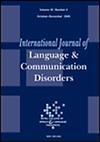Facilitating Spoken Word Retrieval in Chronic Aphasia: A Case Series Investigation of Orthographic Cues With and Without Phonological Support
Abstract
Background
Current clinical approaches to the treatment of spoken word-finding difficulties in acquired aphasia encourage multimodal cueing, especially the joint application of written and spoken forms. Research that exclusively examines the effects and mechanisms of written cues is limited, with most studies engaging written forms only as part of a multimodal therapy. Parameters for ideal orthographic cue size and mode of delivery have yet to be determined, and the duration of orthographic facilitation effects needs to be clarified.
Aims
(1) What is the optimal unit of orthographic cueing (single letter or the entire word) and how durable are the effects (length of time that naming remains successful post-cueing)? (2) Are orthographic cues alone less effective when compared to orthographic-and-phonological cue combinations?
Method and Procedures
Five English-speaking monolinguals with post-stroke anomia completed a facilitation study, focusing on cued single spoken-word picture-naming. Linguistic unit (initial letter of the word vs. whole word) and cueing medium (‘orthographic-only’ vs. ‘combined orthographic and phonological’) were manipulated, with naming accuracy and response times (RTs) measured. Naming performance was evaluated at baseline and at two post-facilitation time points (15 min and 1 week post-facilitation).
Outcomes and Results
Three outcome measures—number of items accurately named as initial and final naming responses (accuracy scores), as well as RTs—were analysed for each participant, with effects of repeated exposure (if any) taken into account. Three participants significantly improved following whole word ‘orthography-only’ cues on at least one of the outcomes, whilst one participant improved following initial letter written-only cues. For ‘combined orthographic-and-phonological’ cues, two participants also benefitted when given the entire word, but none significantly improved with initial letter multimodal cueing.
Conclusions and Implications
(1) This study provides case-level evidence on the efficacy of ‘orthography-only’ cues (both ‘Initial letter’ and ‘Whole word’ levels) to improve spoken naming, extending previously documented effects of a single application of a written cue to potentially 1 week later. This suggests a one-off application of a written cue could potentially be more durable than previously thought. (2) There is also evidence from two participants who benefitted from a combined orthographic-and-phonological cue, although these effects were comparatively short-lived. Taken together, these results caution a need to be sensitive to individuals’ residual strengths/weaknesses post-stroke, rather than advocating the same strategy for all, including the indiscriminate use of multimodal cues. Our findings also provide a basis for further exploration of orthographic cueing as a therapeutic intervention for post-stroke word-finding deficits.
WHAT THIS PAPER ADDS
- Compared to research on other types of cues (e.g., semantic prompts), the literature on ‘orthography only’ cues is slim. Recent research, however, indicated that written cues are effective in treating word-finding difficulties. Outstanding questions remain, including the efficacy of different orthographic units and the corresponding duration of their effects. It is also unclear which language pathway(s) underpin(s) successful orthographic cueing.
- The paper addresses gaps in our knowledge: (1) It provides fresh evidence to support the use of two units of orthographic prompts, that is, initial letter and whole word cues. (2) There is clarification that a single application of a written whole word can last for at least 1 week, which is a significant advancement from the previously evidenced duration of 10 min for written cues in general. (3) As far as we are aware, this study is the first in aphasiology that distinguishes and analyses naming accuracies of both initial and final responses.
- (1) Case-level data presented in this paper can be used by clinicians as references to gauge whether specific clients would best benefit from orthographic or combined orthographic-phonological cues. Understanding that an orthographic cue may have a durability of a week for a specific profile of individuals will also help clinicians develop more realistic intervention plans. All these are in keeping with efficient case management and evidence-based practice. (2) A reading task can determine who is able to rely on the multiple pathways to utilise an orthographic cue. To more effectively identify people with aphasia suitable for written-only cues, individuals may be screened on a reading-aloud task. (3) There is at least one participant who improved on naming through mere exposure to pictures without cueing, and this exposure was limited to a one-off encounter. Accounting for effects from repeated priming is thus necessary before one draws conclusions about the effects of cues on spoken word retrieval.

 求助内容:
求助内容: 应助结果提醒方式:
应助结果提醒方式:


